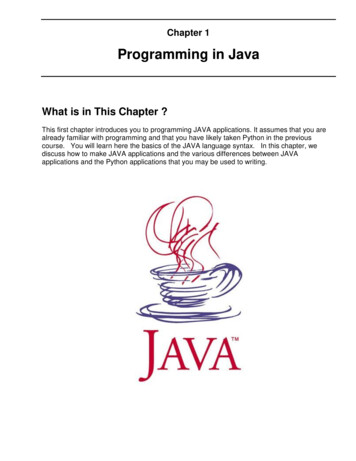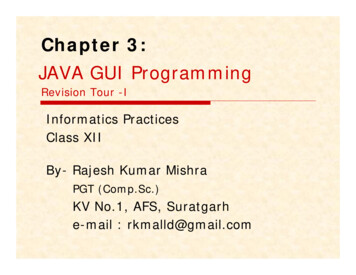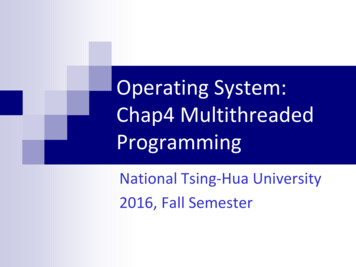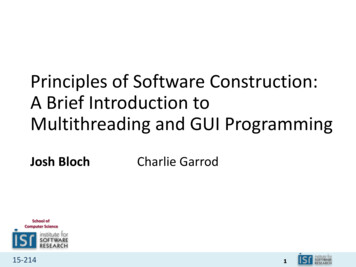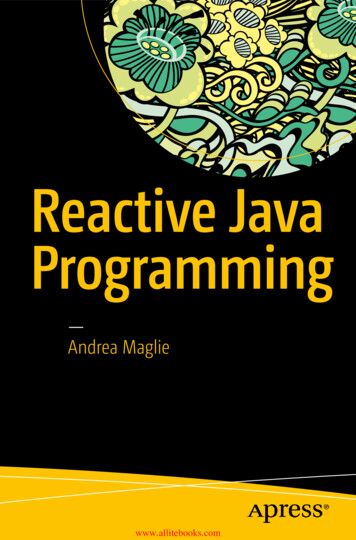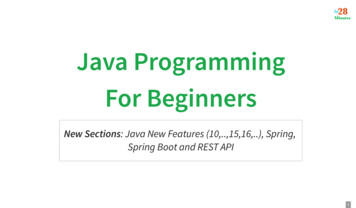
Transcription
JavaMultithreadedProgrammingThis chapter presents multithreading, which is one of the core features supported by Java. The chapter introduces the need for expressing concurrency to support simultaneous operations within Java programs,especially those offering network services. It also introduces multithreading programming constructs in Javaincluding synchronization techniques with examples.OA er learning the contents of this chapter, the reader must be able to :B JECTunderstand the importance of concurrencyunderstand multithreading in Javacreate user-defined classes with thread capabilitywrite multithreaded server programsunderstand the concurrent issues with thread programmingChapter14IVES14.1INTRODUCTIONIn a networked world, it is common practice to share resources among multiple users. Therefore applicationprograms designed to be deployed in a network should be designed to serve multiple users requestssimultaneously. Even on desktop computers, users typically run multiple applications and carry out someoperations in the background (e.g., printing) and some in the foreground (e.g., editing) simultaneously. Withthe increasing popularity of multicore processors, it is common to see even desktop and laptop computerswith an ability to carry out multiple tasks concurrently. To meet these requirements, modern programminglanguages and operating systems are designed to support the development of applications containingmultiple activities that can be executed concurrently.Modern operating systems hold more than one activity (program) in memory and the processor canswitch among all to execute them. This simultaneous occurrence of several activities on a computer is
Multithreaded Programming365known as multitasking. For example, you can open a file using MS Word and you can work on MS Accessfor creating your database. Two applications, MS Word and MS Access, are available in memory and theprocessor (by means of the operating system) switches to the application you are actively working on.Here two different applications are made to run concurrently by the same processor. The operating systemsupports multitasking in a cooperative or preemptive manner. In cooperative multitasking each applicationis responsible for relinquishing control to the processor to enable it to execute the other application.Earlier versions of operating systems followed cooperative multitasking. Modern operating systems suchas Windows 95, Windows 98, Windows NT, and Windows 2000 support preemptive multitasking. In thepreemptive type multitasking, the processor is responsible for executing each application in a certainamount of time called a timeslice. The processor then switches to the other applications, giving each itstimeslice. The programmer is relieved from the burden of relinquishing control from one application toanother. The operating system takes care of it.A single processor computer is shared among multiple applications with preemptive multitasking.Since the processor is switching between the applications at intervals of milliseconds, you feel that allapplications run concurrently. Actually, this is not so. To have true multitasking, the applications must berun on a machine with multiple processors. Multitasking results in effective and simultaneous utilization ofvarious system resources such as processors, disks, and printers. As multitasking is managed by operatingsystems, we encourage readers to refer to books related to that topic. In this chapter, we focus on learninghow to write an application containing multiple tasks (i.e., objects containing operations to be performed)that can be executed concurrently. In Java, this is realized by using multithreading techniques.14.2DEFINING THREADSTo understand multithreading, the concepts process and thread must be understood. A process is a programin execution. A process may be divided into a number of independent units known as threads. A thread is adispatchable unit of work. Threads are light-weight processes within a process. A process is a collection ofone or more threads and associated system resources. The difference between a process and a thread is shownin Fig.14.1. A process may have a number of threads in it. A thread may be assumed as a subset of a process.Fig. 14.1 A process containing single and multiple threadsIf two applications are run on a computer (MS Word, MS Access), two processes are created.Multitasking of two or more processes is known as process-based multitasking. Multitasking of two or morethreads is known as thread-based multitasking. The concept of multithreading in a programming languagerefers to thread-based multitasking. Process-based multitasking is totally controlled by the operating system.But thread-based multitasking can be controlled by the programmer to some extent in a program.
366Object-Oriented Programming with JavaThe concept of context switching is integral to threading. A hardware timer is used by the processorto determine the end of the timeslice for each thread. The timer signals at the end of the timeslice and inturn the processor saves all information required for the current thread onto a stack. Then the processormoves this information from the stack into a predefined data structure called a context structure. Whenthe processor wants to switch back to a previously executing thread, it transfers all the information fromthe context structure associated with the thread to the stack. This entire procedure is known as contextswitching.Java supports thread-based multitasking. The advantages of thread-based multitasking as compared toprocess-based multitasking are given below: Threads share the same address space. Context-switching between threads is normally inexpensive. Communication between threads is normally inexpensive.14.3THREADS IN JAVAApplications are typically divided into processes during the design phase, and a master process explicitlyspawns subprocesses when it makes sense to logically separate significant application functionalities.Processes, in other words, are an architectural construct. By contrast, a thread is a coding construct thatdoes not affect the architecture of an application. A single process might contain multiple threads (seeFig. 14.2). All threads within a process share the same state and same memory space, and can communicatewith each other directly, because they share the same variables.Threads typically are spawned for a short-term benefit that is usually visualized as a serial task, butwhich does not have to be performed in a linear manner (such as performing a complex mathematicalcomputation using parallelism, or initializing a large matrix), and then are absorbed when no longerrequired. The scope of a thread is within a specific code module—which is why we can bolt on threadingwithout affecting the broader application.Fig. 14.2 A program with master thread and children threads
Multithreaded Programming367Threads are objects in the Java language. They can be created by using two different mechanisms asillustrated in Fig. 14.3:1. Create a class that extends the standard Thread class.2. Create a class that implements the standard Runnable interface.That is, a thread can be defined by extending the java.lang.Thread class (see Fig. 14.3a) or byimplementing the java.lang.Runnable interface (see Fig. 14.3b). The run() method should beoverridden and should contain the code that will be executed by the new thread. This method must be publicwith a void return type and should not take any arguments. Both threads and processes are abstractionsfor parallelizing an application. However, processes are independent execution units that contain theirown state information, use their own address spaces, and only interact with each other via interprocesscommunication mechanisms (generally managed by the operating system).Fig. 14.3 Creation of Threads in Java14.3.1 Extending the Thread ClassThe steps for creating a thread by using the first mechanism are:1. Create a class by extending the Thread class and override the run() method:class MyThread extends Thread {public void run() {// thread body of execution}}2. Create a thread object:MyThread thr1 new MyThread();3. Start Execution of created thread:thr1.start();An example program illustrating creation and invocation of a thread object is given below:
368Object-Oriented Programming with JavaProgram 14.1/* ThreadEx1.java: A simple program creating and invoking a thread object byextending the standard Thread class. */class MyThread extends Thread {public void run() {System.out.println(“ this thread is running . ”);}}class ThreadEx1 {public static void main(String [] args ) {MyThread t new MyThread();t.start();}}The class MyThread extends the standard Thread class to gain thread properties through inheritance.The user needs to implement their logic associated with the thread in the run() method, which is the bodyof thread. The objects created by instantiating the class MyThread are called threaded objects. Even thoughthe execution method of thread is called run, we do not need to explicitly invoke this method directly.When the start() method of a threaded object is invoked, it sets the concurrent execution of the objectfrom that point onward along with the execution of its parent thread/method.14.3.2 Implementing the Runnable InterfaceThe steps for creating a thread by using the second mechanism are:1. Create a class that implements the interface Runnable and override run() method:class MyThread implements Runnable { public void run() {// thread body of execution}}2. Creating Object:MyThread myObject new MyThread();3. Creating Thread Object:Thread thr1 new Thread(myObject);4. Start Execution:thr1.start();An example program illustrating creation and invocation of a thread object is given below:Program 14.2/* ThreadEx2.java: A simple program creating and invoking a thread object byimplementing Runnable interface. */class MyThread implements Runnable {public void run() {System.out.println(“ this thread is running . ”);
Multithreaded Programming369}}class ThreadEx2 {public static void main(String [] args ) {Thread t new Thread(new MyThread());t.start();}}The class MyThread implements standard Runnable interface and overrides the run() method andincludes logic associated with the body of the thread (step 1). The objects created by instantiating the classMyThread are normal objects (unlike the first mechanism) (step 2). Therefore, we need to create a genericThread object and pass MyThread object as a parameter to this generic object (step 3). As a result ofthis association, threaded object is created. In order to execute this threaded object, we need to invoke itsstart() method which sets execution of the new thread (step 4).14.3.3 Thread Class versus Runnable InterfaceIt is a little confusing why there are two ways of doing the same thing in the threading API. It is importantto understand the implication of using these two different approaches. By extending the thread class, thederived class itself is a thread object and it gains full control over the thread life cycle. Implementing theRunnable interface does not give developers any control over the thread itself, as it simply defines theunit of work that will be executed in a thread. Another important point is that when extending the Threadclass, the derived class cannot extend any other base classes because Java only allows single inheritance.By implementing the Runnable interface, the class can still extend other base classes if necessary. Tosummarize, if the program needs a full control over the thread life cycle, extending the Thread class is agood choice, and if the program needs more flexibility of extending other base classes, implementing theRunnable interface would be preferable. If none of these is present, either of them is fine to use.14.4THREAD LIFE CYCLEThe life cycle of threads in Java is very similar to the life cycle of processes running in an operating system.During its life cycle the thread moves from one state to another depending on the operation performed by itor performed on it as illustrated in Fig. 14.4. A Java thread can be in one of the following states: NEWA thread that is just instantiated is in new state. When a start() method is invoked, the threadmoves to the ready state from which it is automatically moved to runnable state by the threadscheduler. RUNNABLE (ready running)A thread executing in the JVM is in running state. BLOCKEDA thread that is blocked waiting for a monitor lock is in this state. This can also occur when a threadperforms an I/O operation and moves to next (runnable) state. WAITINGA thread that is waiting indefinitely for another thread to perform a particular action is in this state. TIMED WAITING (sleeping)A thread that is waiting for another thread to perform an action for up to a specified waiting time is inthis state.
370Object-Oriented Programming with Java TERMINATED (dead)A thread that has exited is in this state.Fig. 14.4 Life cycle of Java threadsAt any given time, a thread can be in only one state. These states are JVM states as they are not linked tooperating system thread states.When the object of a user Thread class is created, the thread moves to the NEW state. After invocation ofthe start() method, the thread shifts from the NEW to the ready (RUNNABLE) state and is then dispatchedto running state by the JVM thread scheduler. After gaining a chance to execute, the run() method will beinvoked. It should be noted that when the run() method is invoked directly (explicitly in the program), thecode in it is executed by the current thread and not by the new thread (as the thread object is not assignedto the virtual machine scheduler). Depending on program operations or invocation of methods such aswait(), sleep(), and suspend() or an I/O operation, the thread moves to the WAITING, SLEEPING,and BLOCKED states respectively. It should be noted that the thread is still alive. After the completion of anoperation that blocked it (I/O or sleep) or receiving an external signal that wakes it up, the thread moves toready state. Then the JVM thread scheduler moves it to running state in order to continue the execution ofremaining operations. When the thread completes its execution, it will be moved to TERMINATED state. Adead thread can never enter any other state, not even if the start() method is invoked on it.14.5A JAVA PROGRAM WITH MULTIPLE THREADSTo illustrate creation of multiple threads in a program performing concurrent operations, let us consider theprocessing of the following mathematical equation:p sin (x) cos (y) tan (z)As these trigonometric functions are independent operations without any dependencies between them,they can be executed concurrently. After that their results can be combined to produce the final result asillustrated in Fig. 14.5.
Multithreaded Programming371Fig. 14.5 Flow of control in a master and multiple workers threads applicationThe main/default thread is called MathThreads, which acts like a master thread. It creates three workerthreads (MathSin, MathCos, and MathTan) and assigns them to compute values for different data inputs.All three worker threads are concurrently executed on shared or dedicated CPUs depending on the type ofmachine. Although the master thread can continue its execution, in this case, it needs to make sure that alloperations are completed before combining individual results. This is accomplished by waiting for eachthread to complete by invoking join() method associated with each worker thread. A complete Javaprogram illustrating this concept is given in Program 14.3.Program 14.3/* MathThreads.java: A program with multiple threads performing concurrentoperations. */import java.lang.Math;class MathSin extends Thread {public double deg;public double res;public MathSin(int degree) {deg degree;}public void run() {System.out.println(“Executing sin of ” deg);double Deg2Rad Math.toRadians(deg);res Math.sin(Deg2Rad);System.out.println(“Exit from MathSin. Res ” res);}}class MathCos extends Thread {public double deg;public double res;
372Object-Oriented Programming with Javapublic MathCos(int degree) {deg degree;}public void run() {System.out.println(“Executing cos of ” deg);double Deg2Rad Math.toRadians(deg);res Math.cos(Deg2Rad);System.out.println(“Exit from MathCos. Res ” res);}}class MathTan extends Thread {public double deg;public double res;public MathTan(int degree) {deg degree;}public void run() {System.out.println(“Executing tan of ” deg);double Deg2Rad Math.toRadians(deg);res Math.tan(Deg2Rad);System.out.println(“Exit from MathTan. Res ” res);}}class MathThreads {public static void main(String args[]) {MathSin st new MathSin(45);MathCos ct new MathCos(60);MathTan tt new MathTan(30);st.start();ct.start();tt.start();try {// wait for completion of all thread and then sumst.join();ct.join(); //wait for completion of MathCos objecttt.join();double z st.res ct.res tt.res;System.out.println(“Sum of sin, cos, tan ” z);}catch(InterruptedException IntExp) {}}}Run 1:[raj@mundroo]Executing sinExecuting cosExecuting tanthreads [1:111] java MathThreadsof 45.0of 60.0of 30.0
Multithreaded ProgrammingExit from MathSin. ResExit from MathCos. ResExit from MathTan. ResSum of sin, cos, tan 373 0.7071067811865475 0.5000000000000001 0.57735026918962571.7844570503761732Run 2:[raj@mundroo] threads [1:111] java MathThreadsExecuting sin of 45.0Executing tan of 30.0Executing cos of 60.0Exit from MathCos. Res 0.5000000000000001Exit from MathTan. Res 0.5773502691896257Exit from MathSin. Res 0.7071067811865475Sum of sin, cos, tan 1.7844570503761732Run 3:[raj@mundroo] threads [1:111] java MathThreadsExecuting cos of 60.0Executing sin of 45.0Executing tan of 30.0Exit from MathCos. Res 0.5000000000000001Exit from MathTan. Res 0.5773502691896257Exit from MathSin. Res 0.7071067811865475Sum of sin, cos, tan 1.7844570503761732Observations on Results A close observation of the output of three different runs reveals that theexecution/completion of threads does not need to be in the order of their start (i.e., invocation of start()method). In Run 1, it so happened that the output of all three threads happen to be generated in the sameorder of their start. However, this is not the case in the next two runs. Because of various operations that areperformed within JVM, threads, and different applications running at different times, it is hard to predictthe precise time at which context-switching occurs. It is possible to enforce the order of execution to someextent by setting different priorities for threads.14.6THREAD PRIORITYIn Java, all the thread instances the developer created have the same priority, which the process willschedule fairly without worrying about the order. It is important for different threads to have differentpriorities. Important threads should always have higher priority than less important ones, while threads thatneed to run quietly as a Daemon may only need the lowest priority. For example, the garbage collectorthread just needs the lowest priority to execute, which means it will not be executed before all otherthreads are scheduled to run. It is possible to control the priority of the threads by using the Java APIs. TheThread.setPriority( ) method serves this purpose. The Thread class provides 3 constants value forthe priority:MIN PRIORITY 1, NORM PRIORITY 5, MAX PRIORITY 10The priority range of the thread should be between the minimum and the maximum number. Thefollowing example shows how to alter the order of the thread by changing its priority.
Object-Oriented Programming with Java374Program 14.5/* ThreadPriorityDemo.java: A program which showsby changing priority. */class A extends Thread {public void run() {System.out.println(“Thread A started”);for(int i 1; i 4; i ) {System.out.println(“\t From ThreadA: i ”}System.out.println(“Exit from A”);}}class B extends Thread {public void run() {System.out.println(“Thread B started”);for(int j 1; j 4; j ) {System.out.println(“\t From ThreadB: j ”}System.out.println(“Exit from B”);}}class C extends Thread {public void run() {System.out.println(“Thread C started”);for(int k 1; k 4; k ) {System.out.println(“\t From ThreadC: k ”}System.out.println(“Exit from C”);}}public class ThreadPriorityDemo {public static void main(String args[]) {A threadA new A();B threadB new B();C threadC new C();threadC.setPriority(Thread.MAX ) threadA.setPriority(Thread.MIN PRIORITY);System.out.println(“Started Thread d Thread d Thread C”);threadC.start();System.out.println(“End of main thread”);}}altering order of threads i); j); k);1);
Multithreaded Programming375This example creates 3 threads, and adjusts the priority of each thread. The possible output of theexample is shown as follows:Started Thread AStarted Thread BStarted Thread CThread B startedEnd of main threadThread C startedFrom ThreadC: k From ThreadC: k From ThreadC: k From ThreadC: k Exit from CFrom ThreadB: j From ThreadB: j From ThreadB: j From ThreadB: j Exit from BThread A startedFrom ThreadA: i From ThreadA: i From ThreadA: i From ThreadA: i Exit from A123412341234The highest priority thread C is scheduled/executed first and the thread A which has the lowest priority isscheduled last.14.7THREAD METHODSThe sleep() method causes the current thread to sleep for a specified amount of time in milliseconds:public static void sleep(long millis) throws InterruptedExceptionFor example, the code below puts the thread in sleep state for 3 minutes:try {Thread.sleep(3 * 60 * 1000); // thread sleeps for 3 minutes} catch(InterruptedException ex){}The yield() method causes the current thread to move from the running state to the RUNNABLE state,so that other threads may get a chance to run. However, the next thread chosen for running might not be adifferent thread:public static void yield()The isAlive() method returns true if the thread upon which it is called has been started but not movedto the dead state:public final boolean isAlive()When a thread calls join() on another thread, the currently running thread will wait until the threadit joins with has completed. It is also possible to wait for a limited amount of time instead for the threadcompletion.
376Object-Oriented Programming with Javavoid join()void join(long millis)void join(long millis, int nanos)A thread exists in a thread group and a thread group can contain other thread groups. This example visitsall threads in all thread groups.// Find the root thread groupThreadGroup root );while (root.getParent() ! null) {root root.getParent();}// Visit each thread groupvisit(root, 0);// This method recursively visits all thread groups under the given group.public static void visit(ThreadGroup group, int level) {// get threads in the given groupint numThreads group.activeCount();Thread[] threads new Thread[numThreads*2];numThreads group.enumerate(threads, false);// enumerate each thread in ‘group’for(int i 0; i numThreads; i ) {// get threadThread thread threads[i];}// get thread subgroups of the given groupint numGroups group.activeGroupCount();ThreadGroup[] groups new ThreadGroup[numGroups*2];numGroups group.enumerate(groups, false);// recursively visit each subgroupfor(int i 0; i numGroups; i ) {visit(groups[i], level 1);}}Here is an example of some thread groups that contain some threads:java.lang.ThreadGroup[name system,maxpri 10]Thread[Reference [Signal em]java.lang.ThreadGroup[name main,maxpri er pair of methods is used for daemon threads. Threads that work in the background to support theruntime environment are called daemon threads. The setDaemon method is used to make the current thread
Multithreaded Programming377as a daemon thread, and the isDaemon method is used to identify whether the current thread is a daemonthread or not.public final void setDaemon(boolean isDaemon)public final boolean isDaemon()The usage of these two methods is intuitive. However, one important thing to notice is that a daemonthread does not mean its priority is very low, in contrast, a thread with minimum priority is not a daemonthread unless the setDaemon method is used to set it.14.8MULTITHREADED MATH SERVERIt is time to implement a more comprehensive threaded application by utilizing the thread programmingyou have learned so far. A sample multithreaded math interaction demonstrating an online math server thatcan perform basic math operations serving clients making simultaneous requests is shown in Fig. 14.6.The multithreaded math server extends the math server from the previous Socket chapter, it enables themath server to concurrently accept client requests and to open a new thread for each socket connection byimplementing the java.lang.Runnable interface. The following code shows how it is implemented.Fig. 14.6 A multithreaded math server and its clientsProgram 14.4/* MultiThreadMathServer.java: A program extending MathServer whichallows concurrent client requests and opens a new thread for each socketconnection. */import java.net.ServerSocket;import java.net.Socket;public class MultiThreadMathServerextends MathServer implements Runnable {public void run() {
Object-Oriented Programming with Java378execute();}public static void main(String [] args)throws Exception {int port 10000;if (args.length 1) {try {port Integer.parseInt(args[0]);}catch(Exception e) {}}ServerSocket serverSocket new ServerSocket(port);while(true){//waiting for client connectionSocket socket ultiThreadMathServer server new MultiThreadMathServer();server.setMathService(new rt a new server thread.new Thread(server).start();}}}As can be seen from the program, the run method just invokes the execute method from the baseMathServer class. The main method of the MultiThreadMathServer has a infinite while loop whena client request comes, it creates a new instance of the MultiThreadMathServer class and starts it as aseparate thread. There is no need to change the client code as the multithreaded version of the Math serviceis totally transparent to the client. The purpose of implementing a multithreaded math server is to enableconcurrent client connections, which means it now can support multiple clients at the same time comparedwith the single thread version. One more thing that needs to be mentioned is that every client socket hasbeen explicitly set at a 14-seconds timeout in order to release critical resources if it is waiting for too long.14.9CONCURRENT ISSUES WITH THREAD PROGRAMMINGThreading is a very powerful technique which is sometimes very hard to control, especially when it isaccessing shared resources. In such cases, the threads have to be coordinated, otherwise it will violate thedata of the whole application. For example, a printer cannot be used to print two documents at the sametime and if there are multiple printing requests, threads managing these printing operations needs to becoordinated. Another example would be simultaneously operating the same bank account: it is not correctto do both deposit and withdraw operations on a bank account at the same time. There are two very basicproblems related to concurrent issues when dealing with multiple threads: read/write problem and producerconsumer problem.
Multithreaded Programming37914.9.1 Read/Write ProblemIf one thread tries to read the data and another thread tries to update the same data, it is known as read/write problem, and it leads to inconsistent state for the shared data. This can be prevented by synchronizingaccess to the data via Java synchronized keyword. For example,public synchronized void update() { }It is better to explain the synchronized approach to access the shared data via a simple example. Consideran example of a bank offering online access to its customers to perform transactions on their accounts fromanywhere in the world, as shown in Fig. 14.7. It is possible that an account holder has given a chequeto some other account holder. If the cheque receipient happens to withdraw the money at the same timethe orginal account holder deposits the money, both parties are performing simultaneous operations on thesame account (as shown in Program 14.7). This situation can lead to incorrect operation on the account.This can be avoided by sychronization, which ensures that only one person is able to perform an operationon a shared data at a time (i.e., in a way operations are sequenced to avoid data inconsistency problems).The following class shows a typical invocation of banking operations via multiple threads.Fig. 14.7 Online Bank: Serving Many Customers and OperationsProgram 14.6/* InternetBankingSystem.java: A simple program showing a typical invocation ofbanking operations via multiple threads. */public class InternetBankingSystem {public static void main(String [] args ) {Account accountObject new Account(100);new Thread(new DepositThread(accountObject,30)).start();new Thread(new DepositThread(accountObject,20)).start();new Thread(new DepositThread(accountObject,10)).start();new Thread(new WithdrawThread(accountObject,30)).start();
380Object-Oriented Programming with Javanew Thread(new WithdrawThread(accountObject,50)).start();new Thread(new WithdrawThread(accountObject,20)).start();} // end main()}There are 6 threads that access the same Account object simultaneously. The following code shows theoperations that will be performed on each thread.Program 14.7/* Withdra
Java Multithreaded Programming A er learning the contents of this chapter, the reader must be able to : understand the importance of concurrency understand multithreading in Java create user-defi ned classes with thread capability write multithreaded server programs understand the concurrent issues with thread programming This chapter presents multithreading, which is one .


